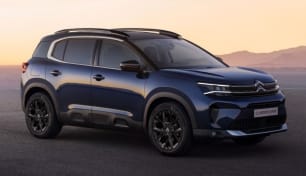The interior is spacious for a medium SUV but the back seat knocks off some points for family practicality. So, let’s start in the back.
Despite there being plenty of headspace for my 168cm (5’6’’) height, the legroom is cosy behind my driving position.
Meaning a 0-4 rearward facing child seat will encroach on front passenger space. It’s probably best suited to a family which is out of the baby stages but it was cumbersome fitting my big harnessed-booster seat in there, too.
It has ISOFIX child seat mounts on the outboard rear seats and three top tethers but two seats will fit best. The floor is flat, which offers far more comfort for a middle seat passenger and I love how the seats can be individually shifted.
The amenities and storage in this row are sparse. You get directional air vents, reading lights, netted map pockets and shallow storage bins in the doors.
Siblings may squabble over the single USB-A port on a long road trip but more than that, there are no cupholders or drink bottle holders back there or even a centre armrest.
That said, the 182mm ground clearance made it an easy car for my six-year-old to get in and out of; plus, the stadium-like seating and wide windows meant he had an awesome view this week.
Now for the front. It has ample amenities, storage and tech. You get plenty of head- and legroom, plus with the panoramic sunroof the cabin manages to feel airy, too.
Individual storage is great with an extra deep middle console, glove box, two cupholders, bins in each door and two very handy utility trays situated near the toggle-type shifter.
Charging options are much better up front, too, and you can choose between a wireless charging pad, two USB-A ports and a 12-volt socket to charge your device.
It's super easy to connect to the wired Apple CarPlay and there’s wired Android Auto for those users.
The built-in satellite navigation is straightforward but that’s where the simplicity ends. I did not find the multimedia system or the digital instrument panel to be terribly intuitive to use and the touchscreen controls can be laggy.
I’m sure you could get used to it over time but I felt flustered.
For this size SUV, the boot space is great at 580L with all seats in use but you can bump it up to 1630L if you fold the back row.
The floor can be adjusted to make a level load space or dropped to give you greater depth for bulkier items and there is a temporary spare tyre underneath the floor.
There are luggage tie-down anchors, a cargo blind and I always like having a powered tailgate.








.png)



































.png)




























